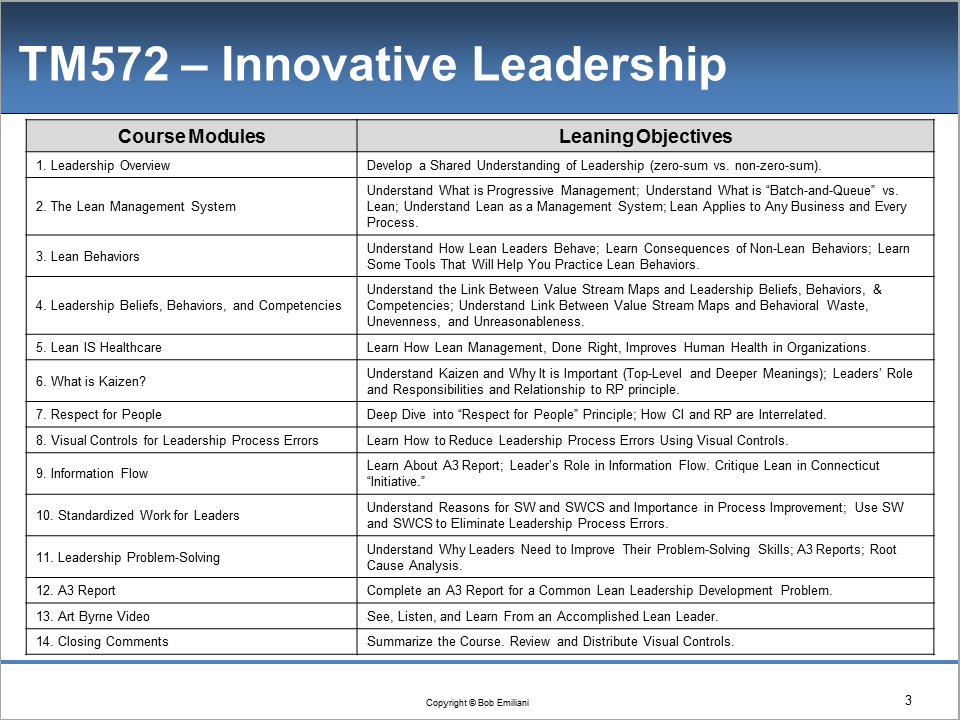For nearly 15 years, I have taught a graduate course on Lean leadership that has prominently featured the “Respect for People” principle and Lean behaviors and behavioral waste concepts that I developed in the mid-1990s. The course, consistently rated 4.8 out of 5.0 for quality of course and instruction, is taken by students pursuing Master’s degrees part-time and who typically have more than 10 years of work experience in all types of companies and industries.
The current course modules and learning objectives are shown in the image on the right. The course has four objectives:
1) Understand leadership processes and leadership process errors.
2) Learn the difference between leadership behaviors that create value and those that are waste.
3) Understand leadership beliefs, behaviors, and competencies in conventionally managed organizations compared to Lean organizations.
4) How to standardize leadership processes to reduce errors and create visual controls that support daily practice.
One the first day, before I say anything about Lean leadership, I ask students a question about the quality and effectiveness of their leaders. I ask: “How do you rate your senior leadership team?” The answer is:
- 11% rate their senior leadership team in the top 25%
- 74% rate their senior leadership team in the middle 50%
- 15% rate their senior leadership team in the bottom 25%
Eleven students out of 100 rate their senior leadership team in the top quartile, while the remainder fall below that. It is safe to say that most leadership teams are mediocre from employees’ perspective. This poor showing reflects the combined effect of leaders’ education, work experience, observations, feedback, and role models – all of which are lacking.
The next question I ask is: “What aspects of corporate leadership can be improved?” Their response shows there is a clear need for improvement:
| Trust employees Listen to employees Respect everyone Spend time with employees Open to new ideas Be more helpful More visible Give feedback Flow of information Communication | Clear objectives Preventive vs. reactive Accessible to employees Realistic deadlines Knowledge of the work Workload management Be available for customers Consistency (say-do) Follow-through Less flavors-of-the-month | Proactive vs. reactive Recognize good work Flexible Ownership of mistakes Faster / timely decision-making Follow company policies Integrity Trusting Be fair Ethical |
Coincidentally, these needs mirror the expectations that they have of leaders – expectations which go unfulfilled for most people.
That is the start of this unique course, which challenges people’s thinking about how organizations are normally led. From there, we explore the leadership behaviors that create value and those that are waste. Students learn about leadership processes and identify the errors that leaders make in each of the processes.
They learn that it is not enough to change one’s behaviors; the beliefs that drive the behaviors must change as well, and we study the means for doing that. And finally, students create visual controls and standardized work to eliminate leadership process errors.
Students complete the course understanding that “Respect for People” alone will not get you there. Instead, it is the interrelationship between the “Respect for People” and “Continuous Improvement” principles that matter most.
Students leave with a far better grasp of leadership than their senior leaders. They possess not just knowledge, but the skills and competencies necessary to become capable Lean leaders at whatever level they are in their organization. They know how to get started and they know they must not wait for their leaders to “get it.”

